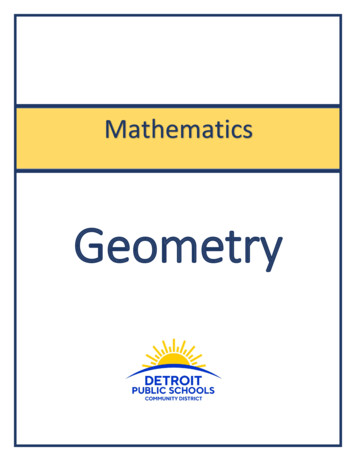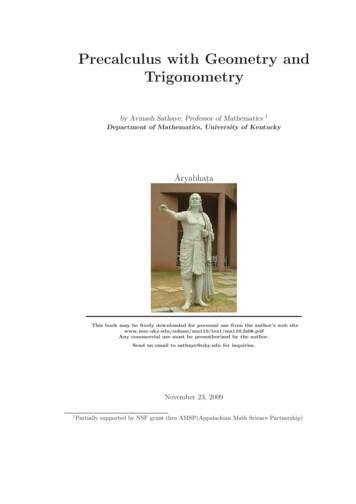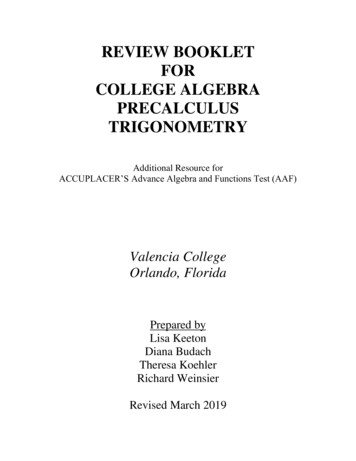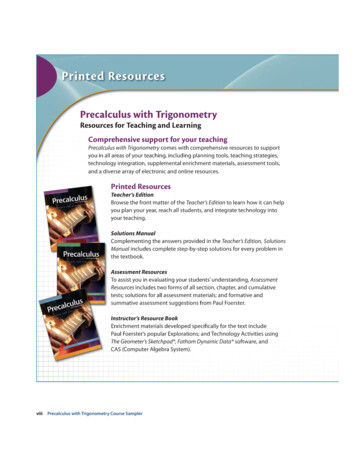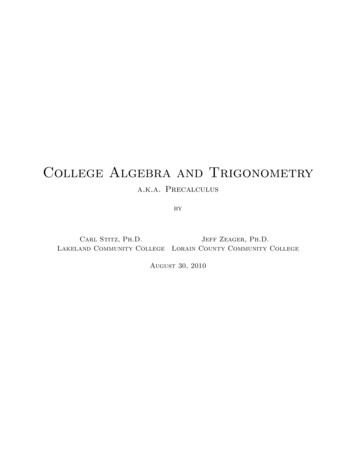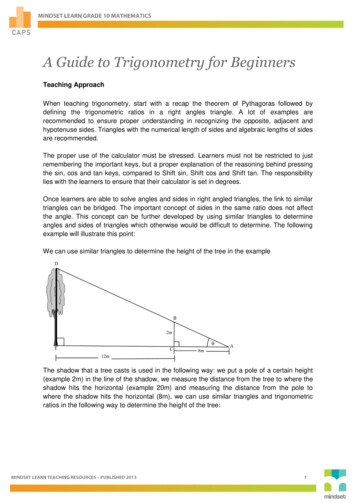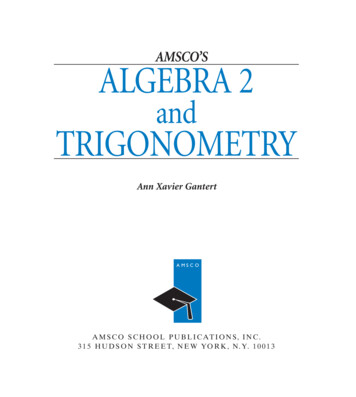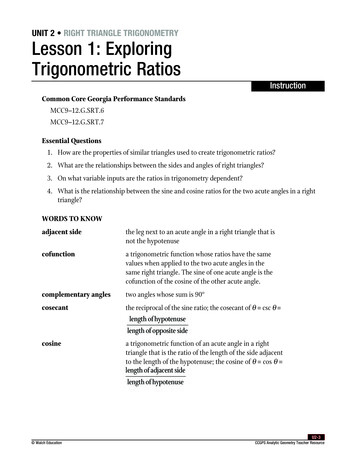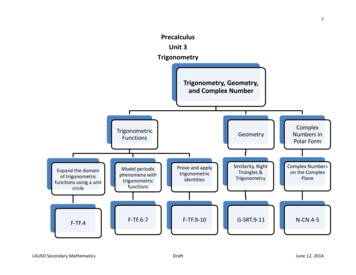
Transcription
7PrecalculusUnit 3TrigonometryTrigonometry, Geometry,and Complex NumberTrigonometricFunctionsExpand the domainof trigonometricfunctions using a unitcircleF-TF.4LAUSD Secondary MathematicsGeometryComplexNumbers inPolar FormModel periodicphenomena withtrigonometricfunctionsProve and applytrigonometricidentitiesSimilarity, RightTriangles &TrigonometryComplex Numberson the ftJune 12, 2014
Pre-Calculus – UNIT 3TrigonometryCritical Area: Students expand their understanding of the trigonometric functions by connecting properties of the functions to the unit circle, e.g.,understanding that since that traveling 2 radians around the unit circle returns one to the same point on the circle, this must be reflected in thegraphs of sine and cosine. Students extend their knowledge of finding inverses to doing so for trigonometric functions, and use them in a wide rangeof application problems. Students derive the addition and subtraction formulas for sine, cosine and tangent, as well as the half angle and double angleidentities for sine and cosine, and make connections between among these. The relationships of general triangles using appropriate auxiliary linesresult in the Laws of Sines and Cosines in general cases, and they connect the relationships described to the geometry of vectors. Students investigatethe geometry of the complex numbers more fully and connect it to operations with complex numbers. In addition, students develop the notion of avector and connect operations with vectors and matrices to transformations of the plane.CLUSTERSCOMMON CORE STATE STANDARDSFunctions – Trigonometric FunctionsExpand the domain of trigonometric functionsusing a unit circle.F-TF.4. Use the unit circle to explain symmetry (odd and even) and periodicity of trigonometricfunctions.Model periodic phenomena with trigonometricfunctionsF-TF.6. Understand that restricting a trigonometric function to a domain on which it is alwaysincreasing or always decreasing allows its inverse to be constructed.F-TF.7. Use inverse functions to solve trigonometric equations that arise in modeling contexts;evaluate the solutions using technology, and interpret them in terms of the context.F-TF.9. Prove the addition and subtraction formulas for sine, cosine, and tangent and use them tosolve problems.Prove and apply trigonometric identitiesSimilarity, Right Triangles & TrigonometryF-TF.10. Prove the half angle and double angle identities for sine and cosine and use them tosolve problems.Geometry – Similarity, Right Triangles, and TrigonometryG-SRT.9. Derive the formula A 1/2 ab sin(C) for the area of a triangle by drawing an auxiliaryline from a vertex perpendicular to the opposite side.G-SRT.10. ( ) Prove the Laws of Sines and Cosines and use them to solve problems.G-SRT.11. ( ) Understand and apply the Law of Sines and the Law of Cosines to find unknownLAUSD Secondary MathematicsJune 12, 2014 DraftPage 24
CLUSTERSComplex Numbers on the Complex Plane[Revisit]COMMON CORE STATE STANDARDSmeasurements in right and non-right triangles (e.g., surveying problems, resultant forces).Number and Quantity – Complex NumberN-CN.4. ( ) Represent complex numbers on the complex plane in rectangular and polar form(including real and imaginary numbers), and explain why the rectangular and polar forms of agiven complex number represent the same number.N-CN. 5. ( ) Represent addition, subtraction, multiplication, and conjugation of complexnumbers geometrically on the complex plane; use properties of this representation for3computation. For example, (–1 3 i) 8 because (–1 3 i) has modulus 2 and argument120 .MATHEMATICAL PRACTICESPROGRESSION1. Make sense of problems and persevere insolving them.2. Reason abstractly and quantitatively.3. Construct viable arguments and critiquethe reasoning of others.4. Model with mathematics.5. Use appropriate tools strategically.6. Attend to precision.7. Look for and make use of structure.8. Look for and express regularity inrepeated reasoning. Indicates a modeling standard linking mathematics to everyday life, work, and decision-making.( ) Indicates additional mathematics to prepare students for advanced courses. ENDURING UNDERSTANDINGSTrigonometric relationships and functions could beused to model real-world phenomenon.Indirect measurements of lengths and angles can beused to solve a variety of problems.The characteristics of circular functions and theirrepresentations are useful in solving real-worldproblems.The relationship between the graph of a complexnumber and their operations and the conjugation ofcomplex numbers on the complex plane can beunderstood.LAUSD Secondary Mathematics1)2)3)4)5)ESSENTIAL QUESTIONSHow can the graphs of the sine, cosine, tangentfunctions and their inverses be compared?How can you use the addition and subtractionformulas for sine, cosine, and tangent to solveproblems?How can you find the inverse of a trigonometricfunction?How can you solve trigonometric equations usinginverse functions?How can technology be used to evaluate solutions ofKEY VOCABULARY amplitudeasymptotecomplex numbercosecant (csc)cosine (cos)cotangent (cot)coterminal angleseven functioninversemidlineJune 12, 2014 DraftPage 25
ENDURING UNDERSTANDINGS The proof of addition and subtraction of identities arederived from the unit circle. Domain must be limited to finding the inverse of atrigonometric function.Inverse functions must be used to find solutions in somemodeling problems.ESSENTIAL QUESTIONStrigonometric functions?6) How can you graph a complex number in rectangularand polar form?7) What is the relationship between rectangular andpolar form of a complex number?8) What is the importance of knowing the conjugate ofa complex number?In terms of their respective equations, what is thedifference between a circle and an ellipse?RESOURCESIllustrative Mathematics Axonometry: N-CN.4, N-CN.5http://illuminations.nctm.org/Lesson.aspx?id 4228 Graphs from the Unit Circle: F-TF.4http://illuminations.nctm.org/Lesson.aspx?id 2870 http://illuminations.nctm.org/Search.aspx?view search&kw identities&gr 9-12KEY VOCABULARY odd function period periodic functions phase shift polar form quadrantal angles rectangular form secant (sec) sine (sin)tangent (tan)INSTRUCTIONAL STRATEGIESUse the values on a unit circle to generate the graphs of thesine and cosine functions on the coordinate plane.ASSESSMENTIllustrative MathematicsProperties of ematics.org/illustrations/1704Explore different ways to prove the Law of Sines andCosines. Derive the Law of Sines from the formula of thearea of the non-right triangle.Use properties of difference of two squares to find themodulus. Relate the modulus visually using vectors. Cutting Conics: d 2907Graph complex numbers and identify the magnitude of thecomplex number, the distance of the complex number fromthe origin, and the direction of the complex number fromthe origin. Shrinking Candles: T-TF.7http://illuminations.nctm.org/Lesson.aspx?id 1211Express complex numbers in polar coordinate form and inrectangular form. Human Conics – d 3003Tie measures in special right triangles to values on the unitcircle and use those values to generate a relationshipbetween the angles and the corresponding locations on theunit circle. Foxes and Rabbits: F.TF.5(2007)LAUSD Secondary MathematicsThe algebraic proofs for sum and difference formulas forsine and cosine flow nicely once you know the cosineformulas. First use the distance formula and PythagoreanJune 12, 2014 DraftPage 26
matics/illustration pdfs/000/000/817/original/illustrative mathematics 817.pdf?1390750613Wolfram Demonstration: N-CN.4 gage New York ssessments.pdf : N-CN.4 and N-CN.5INSTRUCTIONAL STRATEGIESASSESSMENTidentity to derive the cosine formulas. Then allow studentsto derive the formulas for sine and tangent.Have students explore the conic sections and describe howto cut a cone to create various conic sections.Import images of circles from fields from Google Earthinto a coordinate grid system and find their equations.LAUSD Adopted TextbooksPrecalculus Enhanced with Graphing Utilities, 4th Edition ,Sullivan & Sullivan, Pearson/Prentice Hall (2005).Precalculus Graphical, Numerical, Algebraic, 7th edition,Demana, Waits, Foley & Kennedy, Addison Wesley,Pearson Education (2007).Pre-Calculus with Limits: A Graphing Approach, 5thedition, Larson, Hostetler, and Edwards,Houghton/Mifflin, Boston/New York (2008).Precalculus with Trigonometry Concepts andApplications, 2nd edition, Foerster, Key CurriculumLANGUAGE GOALSWriting:1. Students will explain in writing how to prove and apply the Laws of Sines and Cosines using technical vocabulary in complex sentences.Example: To derive the Law of Sines from the formula of the area of the non-right triangle, I (draw the altitude) h from the (vertex) A of the triangle fromthe definition of the (sine function).2. Students will explain (in writing and orally) the terms and definitions of the trigonometric functions; conic sections; and complex numbers.Example: To find the (amplitude) of the function, I can first find the (midline) and then find the distance to the (maximum or minimum) of the graph.3. Students will compare and contrast in writing the differences between a circle and an ellipse.LAUSD Secondary MathematicsJune 12, 2014 DraftPage 27
LANGUAGE GOALSExample: I can derive the formula A 1/2 ab sin (C) for the area of a triangle by drawing an (auxiliary line) from a (vertex) that is (perpendicular) to theopposite side.Listening and Speaking:4. Students will generate class discussions using academic vocabulary related to the rectangular and polar forms of complex numbers.Example: Complex number can be expressed in (polar coordinate) form and in (rectangular form) by .Reading:5. Students will read a word problem and identify the language needed to create an algebraic representation in order to solve the problem.PERFORMANCE TASKSPre-Calculus with Limits: A Graphing Approach, 5th edition, Larson, Hostetler, and Edwards, Houghton/Mifflin, Boston/New York, 2008.F-TF.4. - Electrical Circuits, #73, page 275;F-TF.7 – Photography, page 329 #83;F-TF.9 – Standing Waves, page 385, #79; Harmonic Motion, page 386, #80,F-TF.10 – Railroad Track, page 397, #129; Mach Number, page 398, #128.G-GPE.3 – Architecture, page 678, #47- 49;G-SRT.10 – Surveying, page 422, #38; Landau Building, page 422, # 45. FRONT LOADINGInvolve students to have a discussion thatcenter around extending their knowledge ofcreating and analyzing systems of linearequations and inequalities. Have them usetheir prior knowledge of graphing linearequations to approach system of linear andquadratic equations with two variables.Engage students in an activity that wouldinvolve comparing linear equations withquadratics equations, and then quadraticsequations and exponential equations.Have students match linear, quadratic, andexponential functions with their graphs,tables, and equations.Direct students to connect the idea offunctions with trigonometry and see sine,LAUSD Secondary Mathematics DIFFERENTIATION ACCELERATIONConsider using Application Problems found in thetextbook for real-world examples that can besolved by writing an equation, and have studentsexplore the graphs of equations using technologyapplication.Provide examples of real-world problems that canbe modeled by writing linear, polynomial, rational,absolute value, exponential, and logarithmicfunctions. Have students use technology to graphthe functions, make tables of values, or findsuccessive approximations resulting from thefunction. Include cases where f(x) and/or g(x) arelinear, polynomial, rational, absolute value,exponential, and logarithmic functions. INTERVENTIONShow students how to create numericalequations and then introduce linear equationsin one variable. Students can makecomparisons using the numerical and linearequations.For graphing, have students make a T-chartof the equations, graph them and themanalyze, find the intersection of theequations, and then explain what that means.Include a case where they would comparesimple linear and quadratics equations, e.g.y 2x and y x2Precalculus intervention should includestrategies such as targeted grouping peer andcounseling grouping,June 12, 2014 DraftPage 28
FRONT LOADINGcosine, and tangent values as functions ofangle values input in radians.Review the definition of circles as a set ofpoints whose distance from a fixed point isconstant.Review the algebraic method of completingthe square.Illustrate conic sections geometrically ascross sections of a cone.Have students define conic sections andillustrate it picturically.If the imaginary unit i is misinterpreted as-establish a definitionof i. DIFFERENTIATION ACCELERATIONGive students examples of real-world problems that can be solved by writing an equation, and havestudents explore the graphs of the equations usingtechnology application to determine which parts of the graph are relevant to the problem context.Have students write a system of two equations intwo variables where one equation is quadratic andthe other is linear such that the system has nosolution. Explain, using graphs, algebra and/orwords, why the system has no solution. INTERVENTIONUse informal techniques frequently duringregular class time to gauge studentunderstanding.Use questioning that focuses on studentthinking and reasoning to help you monitoryour students.Incorporate writing activities and group workto observe student thinking and identifymisconceptions and gaps in understanding.Have students illustrate concepts usingdrawings, graphs, and models.Many students who need interventionstruggle to learn concepts because they maynot be able to grasp abstract concepts.Whenever possible, vary your instructionaltechniques to include use of models,manipulatives, and technology.References:1. National Governors Association Center for Best Practices, Council of Chief State School Officers. (2010). Common Core State Standards (Mathematics).Washington D.C.: National Governors Association Center for Best Practices, Council of Chief State School Officers.2. McCallum, W., Zimba, J., & Daro, P. (2011, December 26 Draft). Progressions for the Common Core State Standards in Mathematics. Cathy Kessel(Ed.). Retrieved from e.3. Engage NY. (2012). New York Common Core Mathematics Curriculum. Retrieved from ra-i.4. Mathematics Assessment Resource Service, University of Nottingham. (2007 - 2012). Mathematics Assessment Project. Retrieved . Smarter Balanced Assessment Consortium. (2012). Smarter Balanced Assessments. Retrieved from http://www.smarterbalanced.org/.6. Partnership for Assessment of Readiness for College and Career. (2012). PARCC Assessments. Retrieved from http://www.parcconline.org/parccassessment.7. California Department of Education. (2013). Draft Mathematics Framework Chapters. Retrieved ters.asp.8. National Council of Teachers of Mathematics (NCTM) Illuminations. (2013). Retrieved from http://illuminations.nctm.org/Weblinks.aspx.LAUSD Secondary MathematicsJune 12, 2014 DraftPage 29
9. The University of Arizona. (2011-12). Progressions Documents for the Common Core Math Standards. Retrieved fromhttp://ime.math.arizona.edu/progressions.10. Larson, R.; Hostetler, R.; and Edwards, B. H. (2008). Pre-Calculus with Limits: A Graphing Approach, 5th edition. Boston, New York: Houghton/Mifflin.11. Sullivan, M. & Sullivan III, M. (2006). Precalculus Enhanced with Graphing Utilities, 4th edition. New Jersey: Pearson, Prentice Hall.12. Demana, F.D. Waits, B.K. Foley, G.D. & Kennedy, D. (2007). Precalculus Graphical, Numerical, Algebraic, 7th edition. Addison Wesley, PearsonEducation.13. Foerster, P. A.(2007). Precalculus with Trigonometry Concepts and Applications, 2nd edition. Emeryville, CA: Key Curriculum.LAUSD Secondary MathematicsJune 12, 2014 DraftPage 30
LAUSD Secondary Mathematics June 12, 2014 Draft Page 24 Pre-Calculus - UNIT 3 Trigonometry Critical Area: Students expand their understanding of the trigonometric functions by connecting properties of the functions to the unit circle, e.g., understanding that since that traveling 2 radians around the unit circle returns one to the same point on the circle, this must be reflected in the
